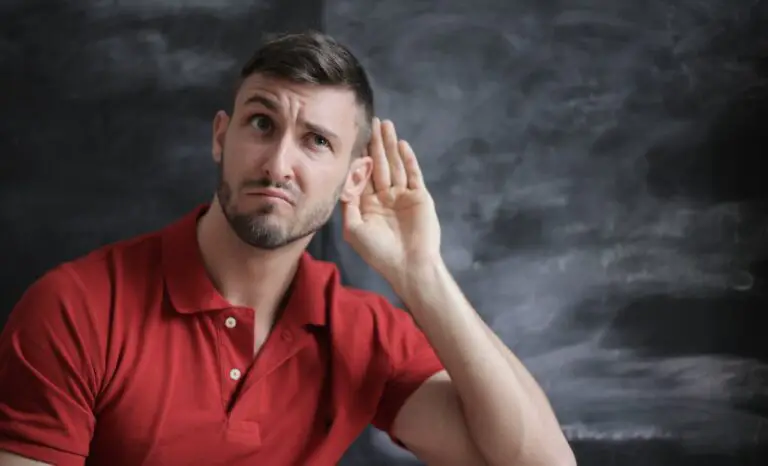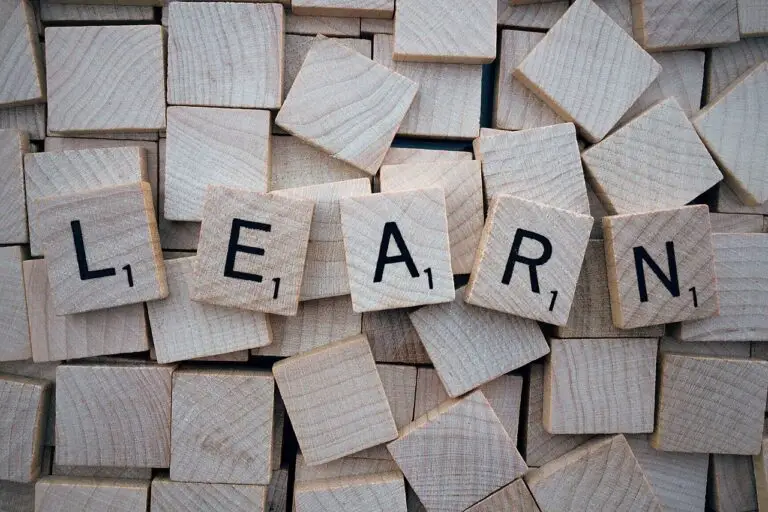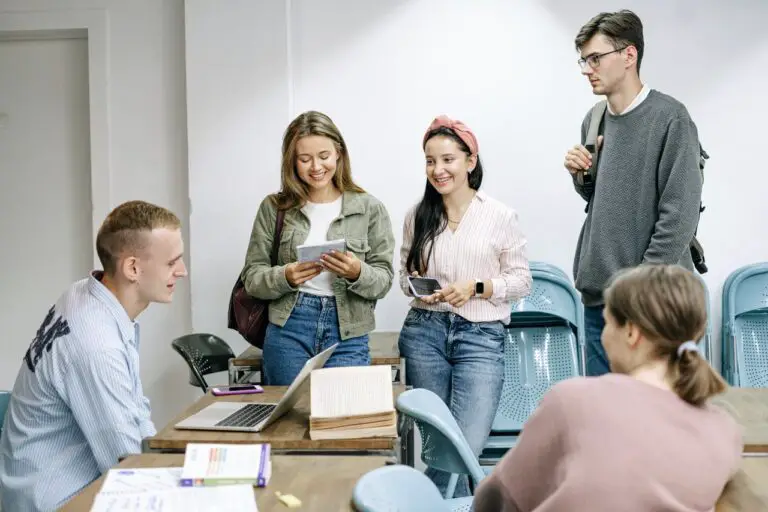I’m not a physical person. Whenever someone suggests dancing or using physical teaching methods, I cringe inside. But when I first learned how gestures and physical hooks improve vocab retention, I knew I was missing out on a powerful teaching technique. Since then, I’ve enjoyed implementing it in all my classes.

Embedding vocabulary using gestures and physical hooks requires linking a physical movement to a specific word or phrase. Gestures must be simple and related to the word’s meaning. The best gestures are those which students invent themselves in a natural manner.
It’s taken some time for me to fully understand the power of gestures and physical hooks in my teaching, and along the way I’ve learned a lot about how (and how not) to use them.
I’m using the terms “gesture” and “physical hook” interchangeably. They both mean a brief physical movement, often with the hands and head.
Using gestures is step 4 of my Best Method to Improve EFL/ESL Students’ Vocabulary: 9 Steps. Be sure to read that guide to get the whole picture. And if you missed the last step, click to go straight there: How to Use Images for Deep Vocab Memorisation in EFL/ESL.
Gestures create strong neural links
By now, everyone knows that most human communication is non-verbal. Body language and physical gestures make up a significant portion of how we interact with each other – it’s a trait found across all cultures of the world.
Teachers have known about this for decades. It’s often used in classroom management to train students to behave correctly, as well as being widely used in language learning, albeit mostly with children.
When we act out a gesture, we’re creating neural pathways in our brains which connect the physical movement to a concept, in this case, a word. Repetition of the gesture reinforces the connection.
Some gestures are cemented in society, for example, the wave of the hand to say “hello” or the nod of the head for affirmation. Circling your finger near your temple shows someone is crazy.
These are deep-rooted and powerful. And we can use them to boost our students’ vocabulary.
Pros and Cons of Total Physical Response
Total Physical Response (TPR) is the most famous gesture-based teaching system. It’s used in EFL classes around the world and for many teachers is the fundamental vocabulary teaching method.
It involves activities where the teacher says a word and the students respond with a physical action. Later, the students may say the word while they’re doing the action. This increases their confidence with the vocabulary without being required to speak it early on.

Personally, I don’t use it in my classes. That’s not to say I don’t recommend it, but it doesn’t work particularly well in the type of classes I teach.
For example, with adults and teens, it’s difficult to base an activity purely around call and response gestures. And even with children, I’m not convinced the repetition of gestures and words on its own is any more powerful than the multitude of other techniques you could use.
Instead, I take the idea and use it to supplement a variety of memorisation methods.
Combined with images, audio hooks and positive memory association (see Best Method to Improve EFL/ESL Students’ Vocabulary: 9 Steps) you can create a diverse neural network with multiple routes to the same word.
Some words work better than others with gestures
Some words have clear, intuitive gestures. Others don’t interact so well with our body, so physical hooks can get confusing.
As a general rule, use gestures with action verbs, simple concrete nouns, and adjectives for emotions and physical descriptions. Avoid linking verbs and non-action verbs as well as most abstract nouns, adjectives and adverbs.
Another reason physical hooks and gestures are more popular when teaching children is that children learn more basic vocabulary – verbs like: walk, jump, sing, and nouns like: rabbit, bottle and school.
The higher the level of English, the more specific and abstract the vocabulary becomes.
Ultimately, you have to decide whether a gesture is suitable for each individual word. Can you think of an appropriate, intuitive gesture for “hotel”? What about “tomato”?
How to get the best out of gestures for memorisation
Sometimes it’s hard to tell whether a gesture will work with a word without trying it. It depends a lot on your students. Their experiences with the meaning of the word will inform how they relate to the physical hook.
That’s why I encourage students to come up with their own.
The gesture they come up with themselves will guarantee a connection to the meaning of the word, so is more likely to help them with memorisation.
Also, let gestures arise organically. This won’t happen all the time with every student, but now and then, students will naturally repeat a gesture while they’re saying a word. Point this out and let them know it’s helping them learn. This way, they’re more likely to do it again and enjoy the process.
Despite my hands-off approach to physical hooks, sometimes I do introduce gestures.
As a teacher, the best thing you can do to get your students using gestures is to use them yourself while you’re speaking.
When you say certain vocabulary (I limit it to target vocabulary for the lesson), do the gesture. As long as it isn’t a ridiculously complicated physical action, your students won’t see it as unusual. As the word appears again, repeat the gesture.
Most students will follow suit once they’ve seen the gesture a few times and they can relate to it themselves. And if they don’t, that’s also fine. Either the gesture doesn’t work for them, or they aren’t particularly physical themselves – just by watching the teacher doing the gesture, they can build some of those important neural connections.
This is something I’ve had to train myself to do. I’m not naturally very expressive while I speak, so it’s take time to adapt. For you, it may come easily, or, like me, you might have to make a conscious effort.
What to avoid when using gestures for memorisation
If you’ve read this far, this first point will come as no surprise – don’t force gestures.
Some students just won’t want to do it, and that’s fine. Creating social stress and resentment towards the teacher will negatively affect their ability to learn, counteracting the benefits of this technique.

Also, avoid unnatural gestures. Even if your students like the physical aspect of the technique, they might not connect with everything. Don’t push the ones that flop. It’ll create dissonance in their mind. Instead, let them adapt the gesture to their own means, or drop it completely.
Some words just don’t work. If you can’t come up with a simple physical hook which reflects the meaning of the word, leave it alone.
Note the word “simple”. Steer clear of overly complicated gestures because the students will end up trying to remember what the gesture was, rather than the word itself. It’s confusing.
What’s also confusing is having too many gestures at once. When the students invent their own physical hooks, this isn’t too much of a problem, but don’t overload them by forcing them to think of too many. Again, they’ll spend vital brain energy just trying to remember what to do with their hands.
And having too many gestures is not only confusing for the students, but for the teacher, too, as you have to keep track of which gestures you’ve taught to which class.
Games to encourage and reinforce gestures
Some games can supercharge the use of gestures. The two listed here induce the creation of new gestures, while also solidifying already established ones.
1. Memory Chain
This is a great vocab recall game, as well as an opportunity to use powerful physical hooks.
Estimated time: 10-15 minutes
Energy level: 3/5
Materials: None
How to play
Organise the students into a circle.
Start the chain with a starter sentence, e.g. “I went to the park and I saw ________”. As the teacher, you can start the chain by supplying the first word/phrase. Let’s say “some ducks”.
The person to the left then repeats the starter sentence and adds their own word/phrase to the chain. For example, “I went to the park and I saw some ducks and a big dog.”
This continues, with each student adding something extra until the chain is so long, people can’t remember it from start to finish.
For best results, treat this game as a collaborative effort rather than a competition. When a student is struggling to remember, allow the others to assist. They’re not allowed to say anything, but they can provide gestures as reminders.
As a teacher, you can initiate this. Take part in the game and when it’s your turn, act out some gestures with the words you say. If someone struggles to remember a word, repeat the gesture for them. Watch as the rest of your students do the same thing to help their peers.
In some cases, the game ends up with everyone doing the gestures while the speaker just says the correct words. You can reach chains of 15-20 words this way. This is many more than without the help from the gestures, and your students love going longer and longer.
TIPS
- Focus your vocabulary by modifying the starting phrase. Learning about food? “I went to the supermarket and I bought ________”. What about sports? “I was watching the Olympics and I saw ________”.
- Praise students for introducing more advanced vocabulary rather than sticking to things they’re already confident about. In fact, you could ban some words for being too easy.
- With more advanced students, encourage them to say phrases like “a pack of hungry dogs” rather than “a dog”.
2. Silent Stories
This activity requires students to come up with their own gestures to tell a story.
Estimated time: 10-30 (longer with larger classes)
Energy level: 4/5
Materials: Timer
How to play
Split the students into groups of 2 or 3.
Give each group a set of 5-10 nouns (more words = more difficult).
Set a timer for 5 minutes to come up with a silent story, using only gestures to depict what happens. They should come up with their own verbs (and the gestures for them) to show how the things interact.
Groups perform their silent stories to the other students, who have to try to understand what’s happening. At the end, see if they can identify the supplied nouns.
The way you choose to apply points and rewards to this game depends on your class. Personally, I’d avoid any scoring at all, and keep it friendly. The excitement of the activity should be enough for most classes, so competition isn’t required.
TIPS
- Supply the teams with vocabulary you’ve learned in the lesson, or in recent lessons.
- Think carefully about which words you give students, as it may be too hard to make gestures with some. Alternatively, if your students are confident, give them more difficult words, so they have to stretch themselves to think up a good gesture.
- If it doesn’t work the first time, don’t give up. It can take a while for students to understand how to use the gestures effectively, and after a few attempts, they’ll get the idea.
For more vocab based games, read my list of 9 High Energy EFL/ESL Games for Boosting Vocabulary
Conclusion
The benefits of using gestures and physical hooks for memorising vocabulary are clear to see. Not so obvious, however, are their limitations.
While they have the potential to provide stronger neural connections than any other memorisation technique, they don’t apply to all words, and trying to force them will result in failure.
Instead, gestures and physical hooks work as targeted supplements. They dovetail with other memorisation techniques in a carefully considered system, such as my Best Method to Improve EFL/ESL Students’ Vocabulary: 9 Steps.
If you’re looking for more memorisation techniques, be sure to check out the next step in my method – Sounds and Audio Hooks for Lasting Memorisation in EFL/ESL.
For all the information you could ever possibly want on teaching EFL/ESL vocab, take a look at all my articles on the topic.
BIG OVERALL GUIDE: Best Method to Improve EFL/ESL Students’ Vocabulary: 9 Steps
Why EFL/ESL Students Forget Vocab: Causes and Solutions
How to Elicit Vocabulary in EFL/ESL: 7 Effective Activities
What Vocab Should You Teach in EFL/ESL: Organic acquisition
How to Use Images for Deep Vocab Memorisation in EFL/ESL
How to Use Gestures to Embed Vocab in EFL/ESL + 2 Games
How to Test EFL/ESL Vocabulary: Best assessment methods
Sounds and Audio Hooks for Lasting Memorisation in EFL/ESL
How to Teach Vocab in EFL/ESL with Memorable Moments
Supercharge EFL/ESL Vocab With Spaced Repetition (Anki)
How to Make Vocab Last Forever: Reinforcing connections
9 High Energy EFL/ESL Games for Boosting Vocabulary






